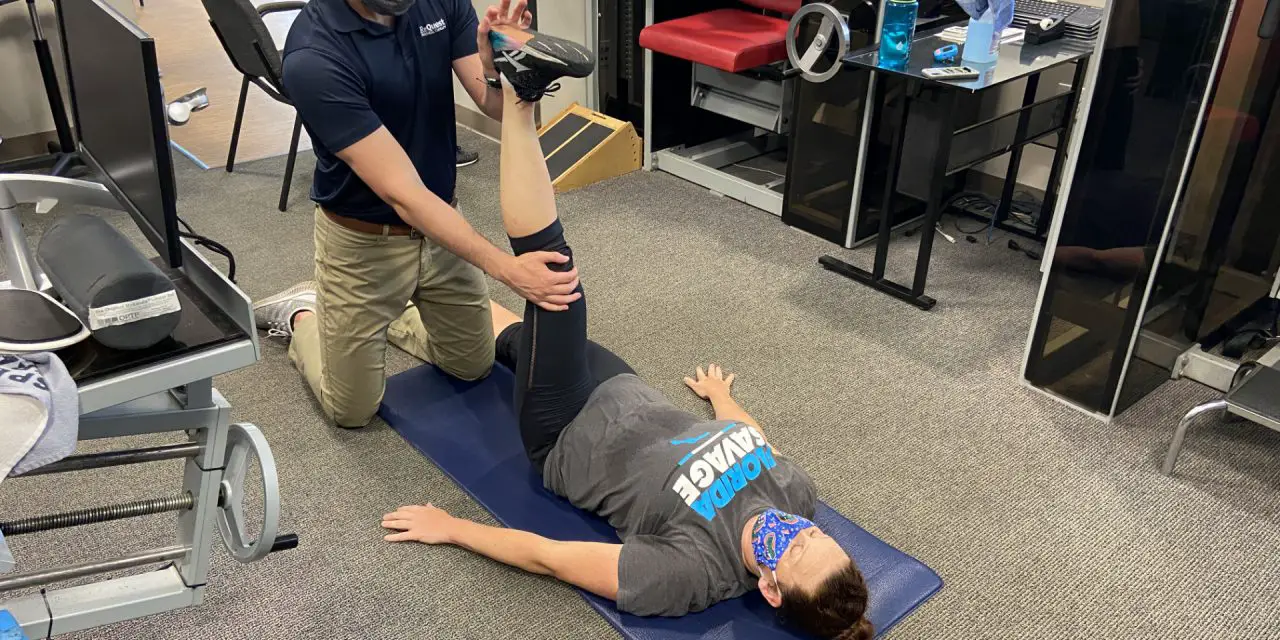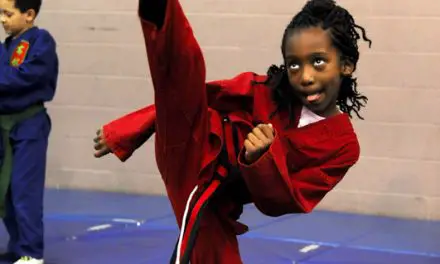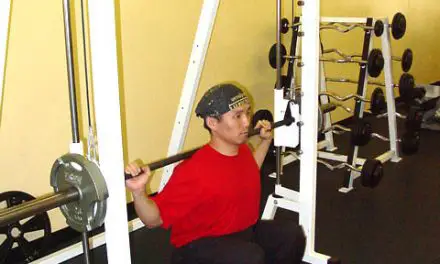Proprioceptive neuromuscular facilitation, or PNF, is thought to be a powerful tool when it comes to the treating problems in the joints and muscles. It’s a type of passive stretching among several types of stretching
- static stretching: holding a stretch for a period of time
- dynamic stretching: moving your joint within your range of motion in a controlled manner
- ballistic stretching: bouncing movements that usually takes the joint or muscle through a short range of motion; less control than dynamic stretching
PNF gives the therapist a dynamic approach to evaluating and treating everything from flexibility and movement issues to ankle sprains and brain injuries.
These structural dysfunctions may include tight tissues or joints that move too much or too little. Addressing these issues is one way to improve your body’s ability to maintain good posture and move well.
When you can coordinate purposeful movement, the result is repetitive stresses to the joints and tissue which creates pain and dysfunction.
Ultimately, the goal of PNF is to create good, healthy movement through the patterns you use for everyday tasks like eating, walking, and putting on a seatbelt. If you move well, you are less likely to apply abnormal stresses to the tissues which eventually lead to breakdown and injury.
If you’re a PNF purist, you know the principles and techniques are the bread and butter of the practice. You also know that PNF is universally applicable regardless of the body part being treated or the extent of dysfunction.
Dr, Robert (Bob) Moore, a long-time athletic training professor in the Department of Exercise and Nutritional Sciences at San Diego State University, was a physical therapist and athletic trainer who worked with athletes at all levels.
He taught PNF to thousands of students all over the world and often told them that once PNF was mastered, none of the other tools in their toolbox were necessary.
PNF stretching definition
PNF was developed by Dr. Herman Kabat and physical therapist Margaret (Maggie) Knott in the 1940s and 1950s as a means to offer neurologically involved patients more than a future in bed.
They studied the work of others who had identified that a muscle response could be influenced by several factors: resistance, stretch reflex, irradiation, and proprioceptive input.
Dr. Kabat partnered with Sister Elizabeth Kenny, who was successfully treating patients with polio using manual resistance and principles of neurophysiology.
The pioneers’ group effort in rehab led to the practice of PNF, which focused attention on resistance, stretch reflex, and manual contacts to improve muscle function in activities of daily living.
At its core, PNF is just as useful today as it was when Kabat and Knott developed it.
PNF can be used to help you with stretching, strengthening, and/or coordination of movement. It uses techniques, such as autogenic inhibition and reciprocal inhibition, to improve flexibility and range of motion.
Although true PNF always involves very specific hand placements that direct the movements, the techniques have been extrapolated to basic planes of motion over the past several decades, such as the sagittal and frontal planes.
Autogenic inhibition occurs when a muscle uses the tension created in it to relax. When you contract a muscle, the golgi tendon organ is triggered to monitor the tension so that it can protect you from injury or damage.
When the tension is too high, the golgi tendon organ sends a warning signal to your central nervous system to relax.
For instance, if you want to stretch your calves, you dorsiflex your foot through the available range of motion.
Once you reach the limit of motion, you push your toes toward the resistance and then relax.
After you relax, you take your ankle to the limit of motion again and repeat until you are no longer gaining flexibility.
In reciprocal inhibition, the muscles on one side of a joint, use the muscles on the other side of the joint to improve motion. The muscle spindle senses the stretch and triggers relaxation of the muscle on the opposite side of the joint.
If you stretch your calf, you move through the full available range of motion first. Once you get to the end, resistance is applied to the top of the foot and your partner cues you to pull into their hand.
When you relax, your partner will take you to the new end point before telling you to pull into their hand again. Activating the muscles on the front of the ankle will create a reflexive relaxation of the calf muscles.
PNF stretching techniques
Once the concepts of autogenic and reciprocal inhibition have been mastered, they can be applied to different PNF techniques.
The performance of PNF stretching may utilize one or more of these techniques:
- Contract-relax: uses contraction of one muscle through its range of motion to cause relaxation in the same muscle
- Hold-relax: uses isometric contraction of one muscle to cause relaxation in the same muscle
- Hold-relax with agonist contraction: uses hold-relax first, then concentric contraction of the muscle on the opposite side to generate extra stretch
Contract-relax
The contract relax technique improves range of motion by causing tissue relaxation.
To perform contract-relax stretching, the partner takes the joint involved in the stretch through its full range of motion.
Resistance is applied in the direction of a concentric, or shortening, contraction. Basically, you’re moving through the range generated by normal action of the muscle being stretched.
Hold the contraction long enough to feel the force develop in the muscle that you’re stretching. Once the force is developed (about 5-6 seconds), you will be cued to relax completely so that your partner can move you to the new motion limit.
If the hamstrings are the target muscle, your partner should passively flex your hip to the point of restriction. Your partner will then provide resistance in the direction of hip extension as you move your leg toward the floor.
When you relax, your partner moves your hip to the new restriction in motion and repeats this process. This continues until you are no longer seeing improvements in your available motion. This is autogenic inhibition.
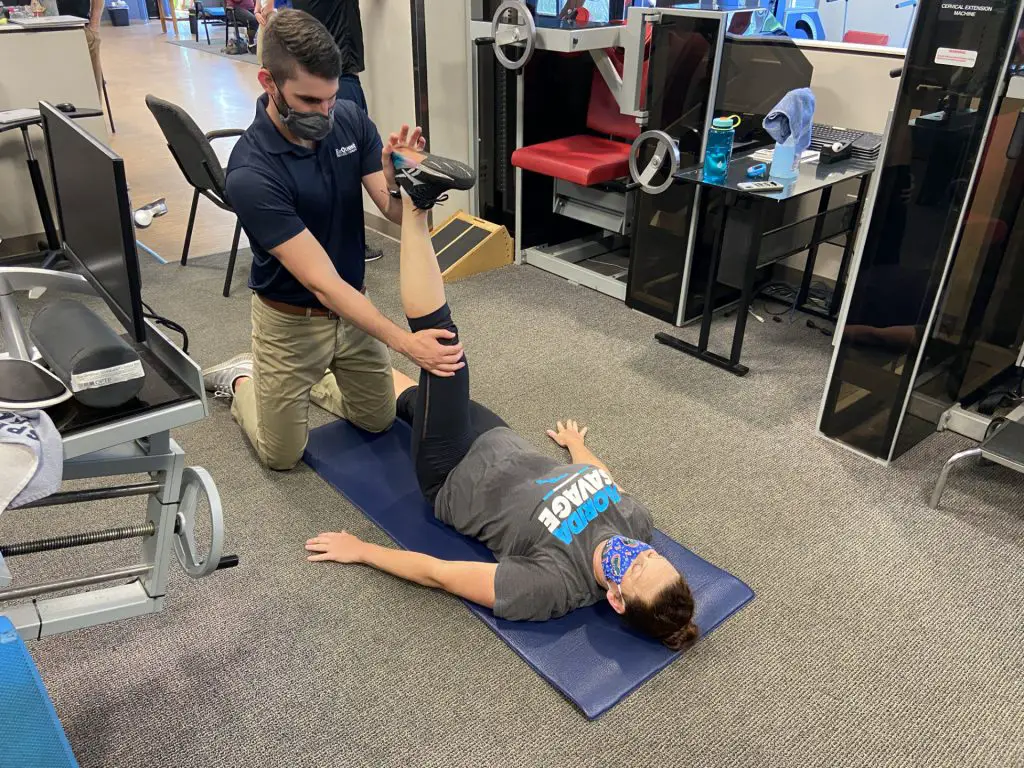
Photo: Penny Goldberg
Hold-relax
In hold-relax stretching, your muscle is taken to the point of restriction and held for a short time.
Next, a 6-second isometric contraction (no visible but the muscle is working) of the muscle being stretched is performed. When you are cued to relax, your partner moves you into the new range.
For example, to stretch your hamstrings, your partner will take your leg into hip flexion until a restriction is felt.
After about 10 seconds of passive stretching, you will be cued to match your partner’s resistance in the direction of hip extension.
The key to an isometric contraction is that there’s no visible movement at the joint so your partner should provide resistance enough that your muscle is working but they shouldn’t let your leg move through any range of motion.
After 6 seconds, relax and your partner takes your leg into the new range.
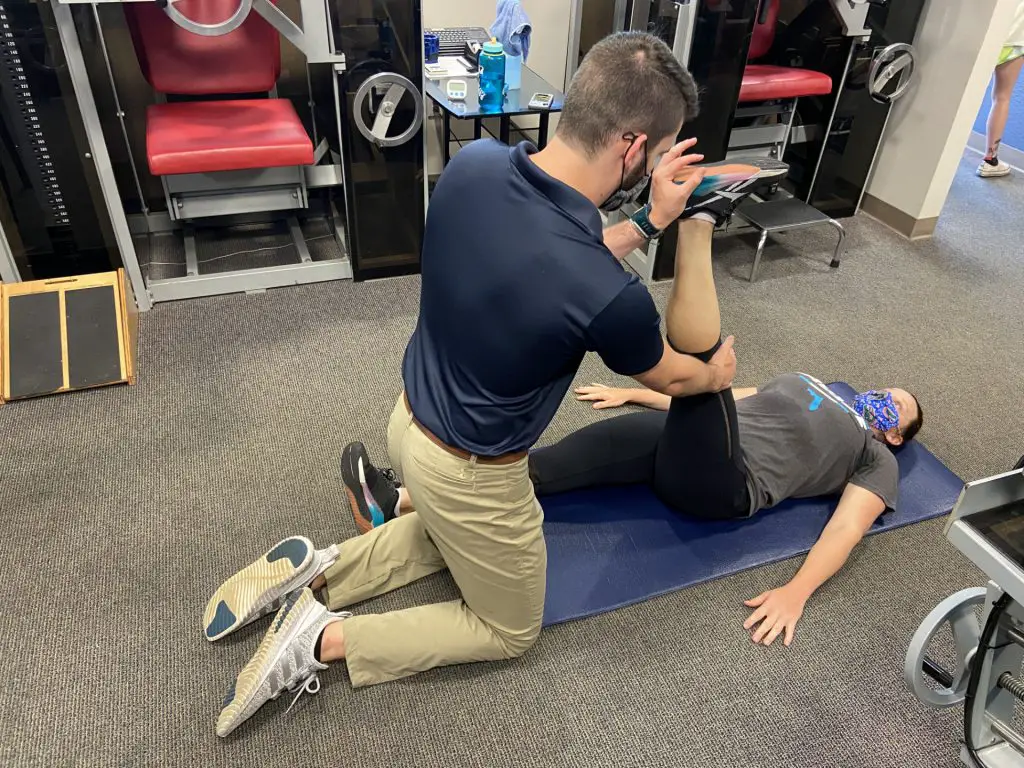
Hold-relax- agonist-contract
Using hold-relax with agonist contraction should be the most effective PNF stretching technique as it’s a combination of autogenic inhibition and reciprocal inhibition.
Hold-relax-agonist-contract has three distinct phases. The first two are the same as regular hold-relax stretching. The third phase uses reciprocal inhibition so rather than being cued to relax, you will be cued to move into the new range.
Once you reach the restriction, your partner applies a stretch and the process may be repeated.
PNF stretching safety
When employing PNF stretching techniques it is important for both the “stretcher” and the “stretchee” to understand that maximum force and contraction are not necessary to create a response in your body.
You can (and should!) use PNF safely and effectively with low level contractions. You should feel the target muscle turn on but you don’t need to be anywhere near maximal force generation.
When your limb is stretched, it should be taken to the point where restriction is felt. There’s no benefit to aggressively applying more pressure to the stretched muscle in this position.
When your partner cues you to contract, think about matching their resistance, not overpowering them. This will ensure that neither of you is injured. The strength mismatch between your hamstrings and your partner’s shoulders can be rather large so be sure to take this into consideration before you push or pull.
PNF stretching can be applied to your upper or lower body and is universally applicable to all muscle groups. In its purest form, these stretches involve specific hand placements and movement in patterns that mimic daily activities.
These patterns are often referred to as D1 and D2 and refer to highly specific movement directions to ensure all of the muscles of a joint are involved in the motion. In its more well known form, the science of PNF is applied to traditional stretching positions. This means you can take any stretch position you can think of and turn it into a PNF stretch. Most times, PNF is thought of as “partner stretching” but it can be done with a wall or other immovable object if a partner isn’t available.
PNF stretching vs. static stretching
A 2017 systematic review found that neither PNF or static stretching is superior when it comes to increasing hip flexion however this may be misleading. Five studies met the inclusion criteria but only one of them measured hamstring length using the clinically accepted technique.
The study that measured hamstring length via hip range of motion during a straight leg raise is the only study to find PNF was a superior approach.
The other four studies used inclinometry and goniometry to measure knee extension angle and found no difference in range motion after the application of stretching regardless of technique.
In the real world, there are a ton of variables involved in stretching which makes it difficult to compare one technique to another.
The age, gender, fitness level, type of stretch, duration of hold, and measurement tool (e.g. stand and reach, sit and reach, straight leg raise, knee extension angle) all play a role in determining the effectiveness of a stretch.
A 2019 systematic review found that PNF stretching improves immediate and short-term flexibility. The data suggest that clinicians should expect large gains in hamstring flexibility specifically when using PNF stretching techniques.
These improvements may be a function of increases in stretch tolerance as much as mechanical and neural factors. Improvement in range of motion after repeated procedures may be a by-product of increased stretch tolerance.
It’s also likely that increasing flexibility over time depends on how dedicated you are to your stretching program. You can make short-term flexibility gains by stretching occasionally but if you want improved flexibility over time, you’re going to have to put in the work.
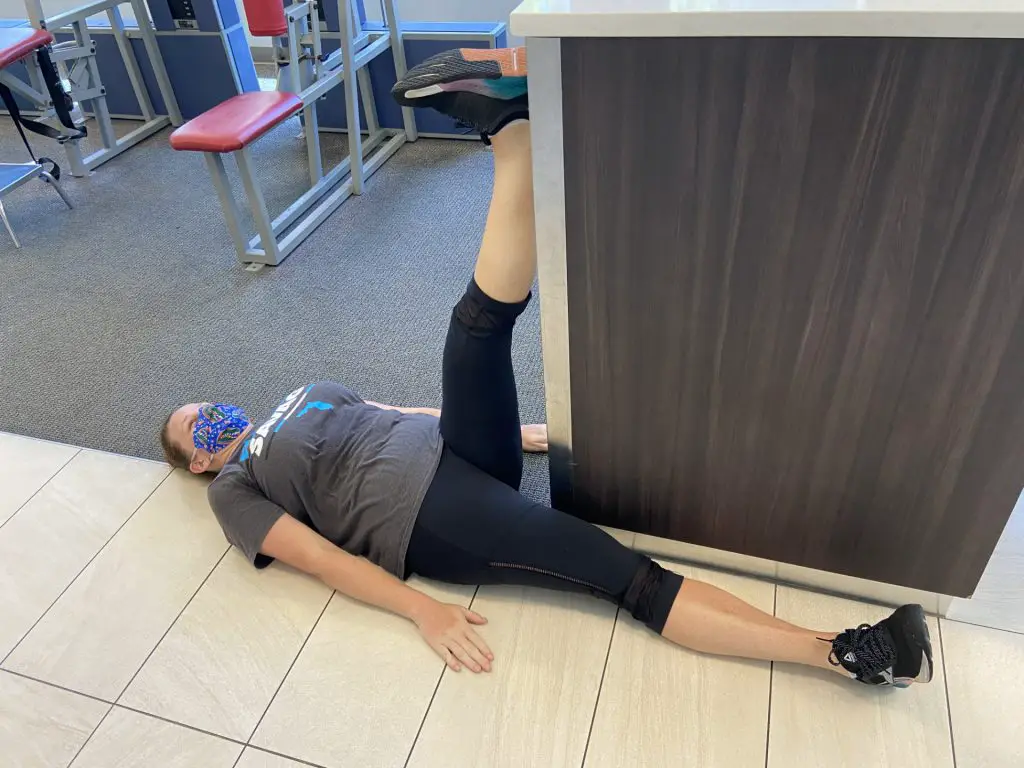
Photo: Penny Goldberg
PNF stretching may not be ideal if you like a solo workout; static or dynamic stretching may be easier to apply in this situation. But if you have a workout partner, PNF may be just what you both need to get long and strong.
Although the evidence found PNF and static stretching creates similar results, PNF was slightly superior right after stretching. For long-term changes, the type of stretching doesn’t seem to make much difference.
If you’ve ever been to a sporting event early enough to see the teams warm-up on the field, you’ve likely seen teammates partner up to stretching. It’s likely they are using PNF stretching to get their bodies primed for performance.
There isn’t convincing evidence that any one stretching technique is better than another. Choosing which type of stretching to use seems to be a highly personal decision. The best stretch for you is the one that you have the time, space, and equipment to perform consistently. If you’re stretching to prepare for a specific activity, your stretching should also mimic the motions involved in that activity.
If a wall or partner isn’t available, static stretching may be the way to go. If your workout partner is readily available and you don’t hate doing it, PNF probably has a slight edge in effectiveness.

Penny Goldberg, DPT, ATC
Penny Goldberg, DPT, ATC earned her doctorate in Physical Therapy from the University of Saint Augustine and completed a credentialed sports residency at the University of Florida. She is a Board Certified Clinical Specialist in Sports Physical Therapy.
Penny holds a B.S. in Kinesiology and a M.A. in Physical Education from San Diego State University. She has served as an Athletic Trainer at USD, CSUN, and Butler University.
She has presented on Kinesiophobia and differential diagnosis in complicated cases. Penny has published on returning to sports after ACL reconstruction and fear of movement and re-injury.
Outside of the clinic, Penny enjoys traveling, good cooking with great wine, concerts, working out and playing with her dogs.

